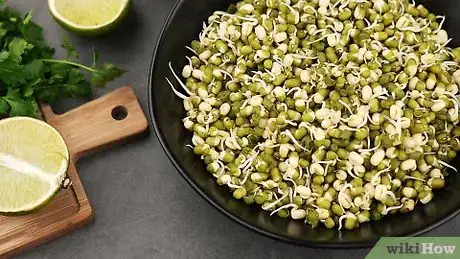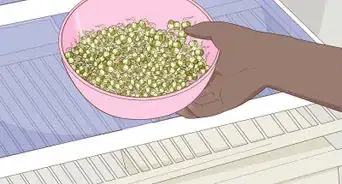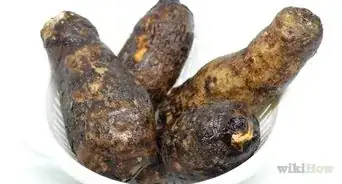This article was co-authored by Vanna Tran, a trusted member of wikiHow's volunteer community. Vanna Tran is a home cook who started cooking with her mother at a very young age. She has catered events and hosted pop-up dinners in the San Francisco Bay Area for over 5 years.
There are 18 references cited in this article, which can be found at the bottom of the page.
wikiHow marks an article as reader-approved once it receives enough positive feedback. In this case, 100% of readers who voted found the article helpful, earning it our reader-approved status.
This article has been viewed 147,756 times.
Learn more...
Mung beans are delicious and versatile beans that can be added to virtually any savory recipe. Either sprout the mung beans to make a fresh, crunchy treat or boil them to create a hearty stew. Mung bean sprouts can be added to sandwiches, salads, stir fries, and noodle dishes. Cooked mung beans can be seasoned and eaten as a stew, added to curries, or used as a substitute in other bean recipes.
Steps
Cooking Dried Mung Beans
-
1Sort the beans. Slowly pour the beans into a large bowl. As you pour, examine each bean carefully. Sometimes bags of dried beans can have small rocks and other inedible debris mixed in.[1]
- Remove any suspicious looking beans as well. Old, wrinkled beans won’t soften well and may hurt your teeth.
-
2Bring some water to a boil. Place a large cooking pot on the stove over high heat. Add about three cups (.7 liters) of fresh water to the pot and let it come to a boil.
- Always cook with cold tap water. Hot tap water can dissolve contaminants in pipe systems that will be carried into your food.[2]
- Add the salt. Yes, really. Despite myths to the contrary, salting only temporarily toughens the beans' skin. The salt actually speeds the cooking of the beans overall, and seasons more evenly if added initially.[3] [4]
Advertisement -
3Add the dried beans. Add one cup (200 grams) of dried mung beans to the boiling water. Give the beans a good stir to help saturate them completely. Don’t worry if a few beans float on the top. As soon as these beans soak up enough water, they will sink to the bottom.
- If want to cook more than one cup of beans, use more water. For every cup of beans, you should boil three cups of water.
- One cup of dried mung beans will yield three cups of cooked beans, or approximately three servings.
-
4Simmer the beans for 45 minutes to 1 hour. After adding the beans, allow the water to return to a boil. Next, lower the heat to medium low. Let the soup simmer for 45 minutes to an hour or until the beans are soft.[5] To check if the beans are ready, remove a small spoonful and allow it to cool before tasting it.
- A simmering pot will release a few small streams of bubbles. If the surface of the liquid is bubbling too much, reduce the heat.[6]
-
5Check your seasoning of the beans and serve. You can blend the soft beans to serve them as a hearty stew, drain them to create a healthy side dish, or add them to your favorite savory recipe. Mung beans can be seasoned with:
Using a Slow Cooker
-
1Sort the beans into the slow cooker. Slowly pour the beans into the slow cooker, examining each bean carefully. If you find any rocks or unusually hard beans, remove them and throw them away. Otherwise, they may hurt your teeth while you’re eating.[9]
- When in doubt, throw the bean away. For example, if you’re not sure if a bean is too old to eat or not, play it safe and discard it.
-
2Add cooking liquid. For every cup (200 grams) of beans, you will need about three cups (.7 liters) of liquid and a teaspoon of salt (the thing about it toughening beans is largely mythical[10] ). You can use fresh water, or vegetable or meat broth but you'll need less salt. However, make sure not to overfill the slow cooker.
- Most slow cookers have a “fill” line on the inside. Otherwise, only fill the slow cooker halfway full.
-
3Add seasonings to the slow cooker. Sprinkle in seasonings such as onion, garlic, or bay leaves. Other delicious seasonings include:
- Butter
- Curry powder
- Shallots
- Ginger
-
4Cook the beans. Place the lid on your slow cooker and turn it on. You can use the “low” setting to cook the beans for 6.5 hours, creating a creamy, soup-like texture. Alternatively, cook the beans on “high” for 3 hours to create a thinner bean dish.[11]
- After one hour, sample the beans periodically to check for doneness. The beans will be done when they’re soft and flavorful.
-
5Adjust seasoning and serve. Salt and pepper the cooked beans to taste. After seasoning, serve the beans immediately. You can add extra cooking liquid to create a vegetable soup, on a bed of rice, or by themselves as a healthy side dish.
- Leftover beans can be kept in the refrigerator for up to five days.[12]
Eating Sprouted Mung Beans
-
1Pour the dry mung beans into a large bowl. Pour the beans very slowly, examining each bean. This will allow you to identify any rocks or other small debris that got caught in the beans.[13]
- If a bean looks suspicious, play it safe and take it out.
-
2Pour water over the beans. Measure out two or three cups (.5-.7 liters) of water for every cup (200 grams) of beans.[14] Next, pour the water over the beans. Don’t worry about any beans that float to the top. They will sink as soon as they soak up enough water.
- Cover the bowl with a lid or wrap it in plastic wrap to protect the beans from debris.
-
3Soak the beans for twenty four hours. Store the bowl of mung beans in a cool, dark place for at least twenty four hours.[15] This will allow the beans to soak up the water and begin to sprout. Choose a low-traffic location to avoid spilling your beans. Some great storage locations include:
- The corner of a pantry
- Under your kitchen sink
- In an unused cabinet
-
4Drain the water and cover the beans. After twenty four hours, drain the water away from the beans. You can either dump the entire mixture in a colander or carefully tip the bowl over the sink. Next, cover the bowl with a piece of cheesecloth, gauze, or a thin dishtowel. This will protect the beans while allowing air flow. [16]
- Return the beans to their cool, dark spot to continue sprouting.
- Cheesecloth can be bought at most gourmet grocery stores, cheese making depots, and online.
-
5Examine the beans. After twenty four to forty eight hours have passed, examine the beans to see if they’re ready to eat. Sprouted beans will have a small white tail and a split bean body. If you prefer bean sprouts with longer tails, let the beans continue sprouting for a few more hours.[17]
- Don’t let the beans sprout for more than a few days. Otherwise, the beans will become waterlogged and flavorless.[18]
-
6Serve the beans. First, rinse the sprouted beans under cold water to remove any unwanted debris or residue. Allow the beans to dry for a few minutes on a plate lined with a paper towel. Serve the beans immediately. Some excellent serving methods include:
- Adding the beans to a salad
- Seasoning the beans with olive oil, salt, and pepper for a fresh side dish[19]
- Lining your sandwich with sprouts for a healthy crunch
Preparing Mung Bean Recipes
-
1Replace most beans with mung beans. Many bean recipes that call for cooked peas, chick peas, or lentils can use cooked mung beans instead. For example, you can make mung bean falafel by substituting soaked chick peas with cooked mung beans.[20] Some other delicious swaps include:
- Using mung beans instead of peas in a split pea soup
- Replacing the chick peas in a cold chick pea salad
- Substitute mung beans for lentils in a warm lentil salad
-
2Add sprouted mung beans to any savory recipe. Sprouted mung beans are incredibly versatile. They can be sprinkled on a salad for a crunchy health boost or sautéed in a stir fry. Some other fantastic ways to use freshly sprouted mung beans include:
- Adding a layer of bean sprouts to your sandwiches
- Stirring mung bean sprouts into your favorite vegetable soup
- Garnishing your favorite Asian noodle dish
-
3Make a mung bean curry. The hearty mung bean pairs deliciously with traditional curry flavors such as garam masala, coconut milk, ginger, and lime.[21] Do an online search to find your new favorite mung bean curry recipe. Alternatively, stir some cooked mung beans into your favorite curry recipe to incorporate extra flavor and nutrition. Some excellent curries include:
- An Indonesian curry such as Gulai Salai Ikan Khas Palembang
- Palak Paneer, an Indian curry
- Slow-cooker Chicken Curry
Community Q&A
-
QuestionDo mung beans need to be soaked before cooking?
 wikiHow Staff EditorThis answer was written by one of our trained team of researchers who validated it for accuracy and comprehensiveness.
wikiHow Staff EditorThis answer was written by one of our trained team of researchers who validated it for accuracy and comprehensiveness.
Staff Answer wikiHow Staff EditorStaff AnswerNo. Because of their small size, mung beans cook faster than most other types of beans. For this reason, it’s not really necessary to soak them. However, if you want to sprout your mung beans, you will need to soak them for a few days.
wikiHow Staff EditorStaff AnswerNo. Because of their small size, mung beans cook faster than most other types of beans. For this reason, it’s not really necessary to soak them. However, if you want to sprout your mung beans, you will need to soak them for a few days. -
QuestionHow long should I boil dried mung beans?
 wikiHow Staff EditorThis answer was written by one of our trained team of researchers who validated it for accuracy and comprehensiveness.
wikiHow Staff EditorThis answer was written by one of our trained team of researchers who validated it for accuracy and comprehensiveness.
Staff Answer wikiHow Staff EditorStaff AnswerIt generally takes about 30-45 minutes for mung beans to become tender when you boil them on the stove top. Split mung beans may cook a little faster (around 25 minutes). Cook the beans longer if you prefer them very soft.
wikiHow Staff EditorStaff AnswerIt generally takes about 30-45 minutes for mung beans to become tender when you boil them on the stove top. Split mung beans may cook a little faster (around 25 minutes). Cook the beans longer if you prefer them very soft. -
QuestionAre raw mung beans poisonous?
 wikiHow Staff EditorThis answer was written by one of our trained team of researchers who validated it for accuracy and comprehensiveness.
wikiHow Staff EditorThis answer was written by one of our trained team of researchers who validated it for accuracy and comprehensiveness.
Staff Answer wikiHow Staff EditorStaff AnswerRaw mung beans, like other legumes, contain lectins, a type of natural toxin that can be harmful if you consume large amounts of it. However, mung beans contain a relatively low concentration of this chemical compared to other beans, such as kidney beans. The main danger of eating raw mung beans or sprouts is that they can sometimes be contaminated with harmful bacteria, such as Salmonella or E. coli.
wikiHow Staff EditorStaff AnswerRaw mung beans, like other legumes, contain lectins, a type of natural toxin that can be harmful if you consume large amounts of it. However, mung beans contain a relatively low concentration of this chemical compared to other beans, such as kidney beans. The main danger of eating raw mung beans or sprouts is that they can sometimes be contaminated with harmful bacteria, such as Salmonella or E. coli.
References
- ↑ https://www.theveggietable.com/blog/cooking-tips/how-to-soak-and-cook-beans-and-legumes/
- ↑ http://www.nytimes.com/2008/01/29/health/29real.html
- ↑ https://www.finecooking.com/article/cooking-beans-in-salt-water
- ↑ https://www.chowhound.com/food-news/54972/does-salting-dried-beans-make-them-harder-to-cook/
- ↑ http://www.greenkitchenstories.com/mung-bean-stew-on-a-budget/
- ↑ http://www.cookinglight.com/cooking-101/techniques/cooking-class-boiling-and-simmering
- ↑ https://www.thekitchn.com/recipe-one-bowl-mung-bean-mealrecipes-from-the-kitchn-180912
- ↑ https://www.thekitchn.com/flavor-combinations-beans-herb-75364
- ↑ https://www.theveggietable.com/blog/cooking-tips/how-to-soak-and-cook-beans-and-legumes/
- ↑ https://pubs.acs.org/doi/abs/10.1021/jf00109a005
- ↑ http://www.nourishingmeals.com/2012/01/mung-beans-and-rice-with-indian-spices.html
- ↑ http://www.eatbydate.com/proteins/beans-peas/beans-shelf-life-expiration-date/
- ↑ https://www.theveggietable.com/blog/cooking-tips/how-to-soak-and-cook-beans-and-legumes/
- ↑ https://sproutpeople.org/growing-mung-bean-sprouts/
- ↑ https://www.youtube.com/watch?v=kaVC0Wv7-x8&feature=youtu.be&t=14
- ↑ http://www.chatelaine.com/health/diet/five-reasons-to-add-bean-sprouts-to-your-salads/
- ↑ https://sproutpeople.org/growing-mung-bean-sprouts/
- ↑ https://sproutpeople.org/growing-sprouts/help/
- ↑ http://www.bobsredmill.com/shop/grains-beans-seeds/mung-beans.html
- ↑ http://www.onegreenplanet.org/vegan-recipe/ayurvedic-falafels/
- ↑ http://themuffinmyth.com/2015/01/22/mung-bean-and-coconut-curry/
About This Article
Before you cook dried mung beans, pour them in a bowl and sort through them, picking out anything inedible and any beans that look old or wrinkled. Then bring about 3 cups of water to boil on the stove. When the water is boiling, add about 1 cup of the sorted beans, and give them a good stir to saturate them. Bring them back to a boil, then let them simmer for 45-60 minutes or until the beans are soft. You can season the beans just before you serve them. For information on how to cook mung beans in a slow cooker, keep reading!

































































